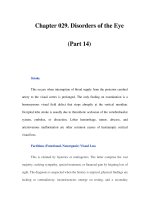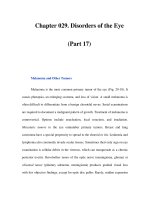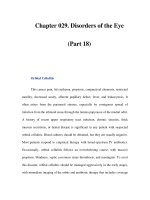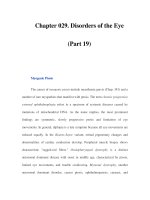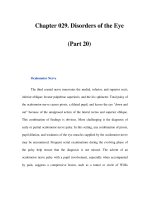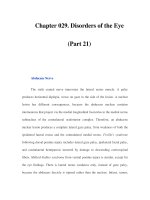Chapter 083. Cancer of the Skin (Part 2) ppsx
Bạn đang xem bản rút gọn của tài liệu. Xem và tải ngay bản đầy đủ của tài liệu tại đây (16.92 KB, 5 trang )
Chapter 083. Cancer of the Skin
(Part 2)
Clinical Characteristics
There are four types of cutaneous melanoma (Table 83-2). In three of
these—superficial spreading melanoma, lentigo maligna melanoma, and acral
lentiginous melanoma—the lesion has a period of superficial (so-called radial)
growth during which it increases in size but does not penetrate deeply. It is during
this period that the melanoma is most capable of being cured by surgical excision.
The fourth type—nodular melanoma—does not have a recognizable radial growth
phase and usually presents as a deeply invasive lesion, capable of early metastasis.
When tumors begin to penetrate deeply into the skin, they are in the so-called
vertical growth phase. Melanomas with a radial growth phase are characterized by
irregular and sometimes notched borders, variation in pigment pattern, and
variation in color. An increase in size or change in color is noted by the patient in
70% of early lesions. Bleeding, ulceration, and pain are late signs and are of little
help in early recognition. Superficial spreading melanoma is the most frequent
variant observed in the white population. Melanomas arising in dysplastic nevi
(see below) are usually of this type. The back is the most common site for
melanoma in men. In women, the back and the lower leg (from knee to ankle) are
common sites. Nodular melanomas are dark brown-black to blue-black nodules.
Lentigo maligna melanoma is usually confined to chronically sun-damaged, sun-
exposed sites (face, neck, back of hands) in older individuals. Acral lentiginous
melanoma occurs on the palms, soles, nail beds, and mucous membranes. While
this type occurs in whites, it is most frequent (along with nodular melanoma) in
blacks and East Asians.
Table 83-2 Clinical Features of Malignant Melanoma
Type Site
Average
Age at
Diagnosis,
Years
Duration
of Known
Existence,
Years
Color
Lentigo
maligna
melanoma
Sun-
exposed
surfaces,
70 5–20
a
or
longer
In flat
portions, shades
of brown and tan
particularly
malar region
of cheek and
temple
predominant,
but whitish gray
occasionally
present; in
nodules, shades
of reddish
brown, bluish
gray, bluish
black
Superficial
spreading
melanoma
Any
site (more
common on
upper back
and, in
women, on
lower legs)
40–50 1–7
Shades of
brown mixed
with bluis
h red
(violaceous),
bluish black,
reddish brown,
and often
whitish pink,
and the border
of lesion is at
least in part
visibly and/or
palpably
elevated
Nodular
melanoma
Any
site
40–50 Months
to less than 5
years
Reddish
blue (purple) or
bluish black;
eithe
r uniform in
color or mixed
with brown or
black
Acral
lentiginous
melanoma
Palm,
sole, nail
bed, mucous
membrane
60 1–10
In flat
portions, dark
brown
predominantly;
in raised lesions
(plaques)
brown-
black or
blue-black
predominantly
a
During much of thi
s time, the precursor stage, lentigo maligna, is confined
to the epidermis.
Source: Adapted from AJ Sober, in
Pathophysiology of Dermatologic
Diseases, NA Soter, HP Baden (eds). New York, McGraw-Hill, 1984.
A fifth type of melanoma, the desmoplastic melanoma, is recognized. This
tumor type is associated with a fibrotic response to the tumor, neural invasion, and
a higher tendency to local recurrence. Occasionally, melanomas can be
amelanotic, in which case the diagnosis is established histologically after biopsy of
a new or changing skin nodule or because of a suspicion of a basal cell carcinoma
(see below).



